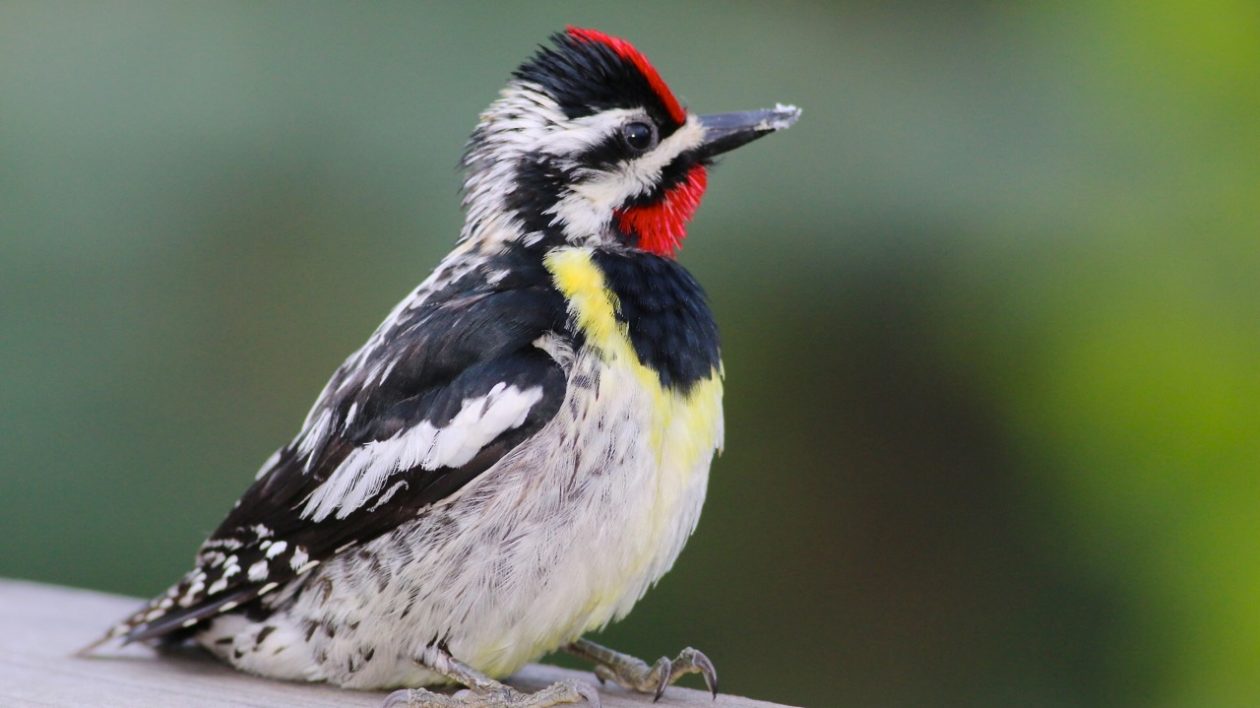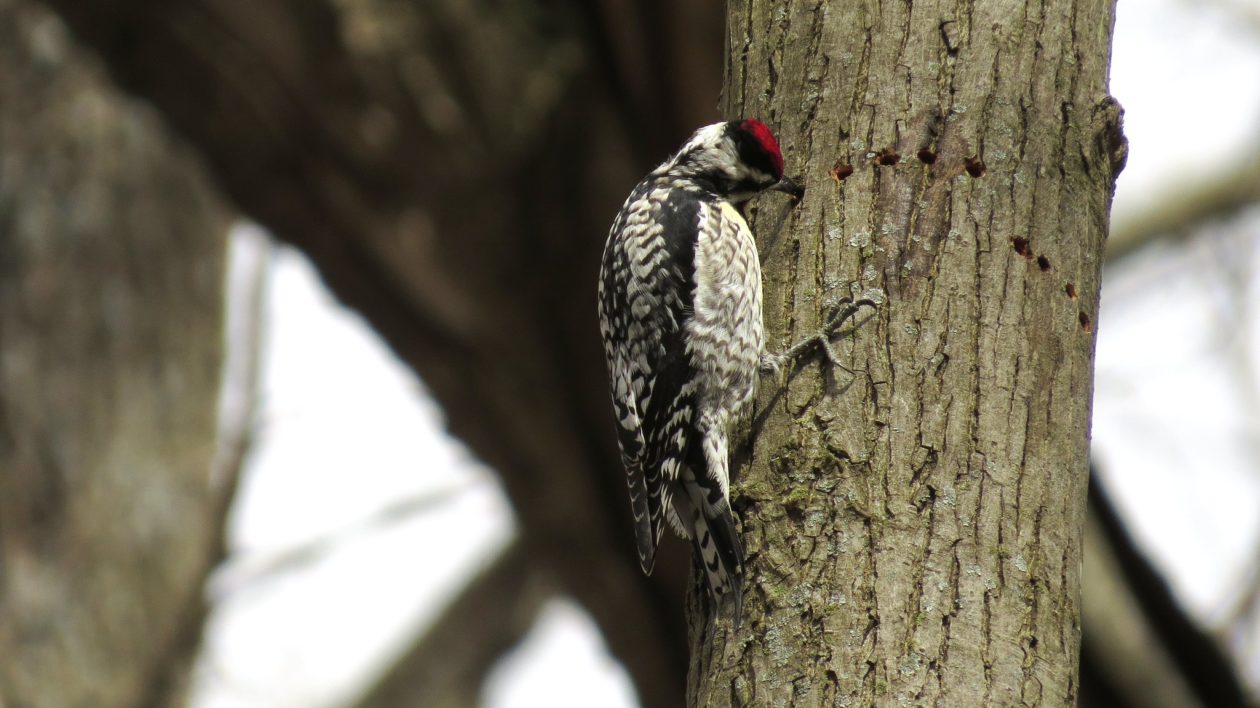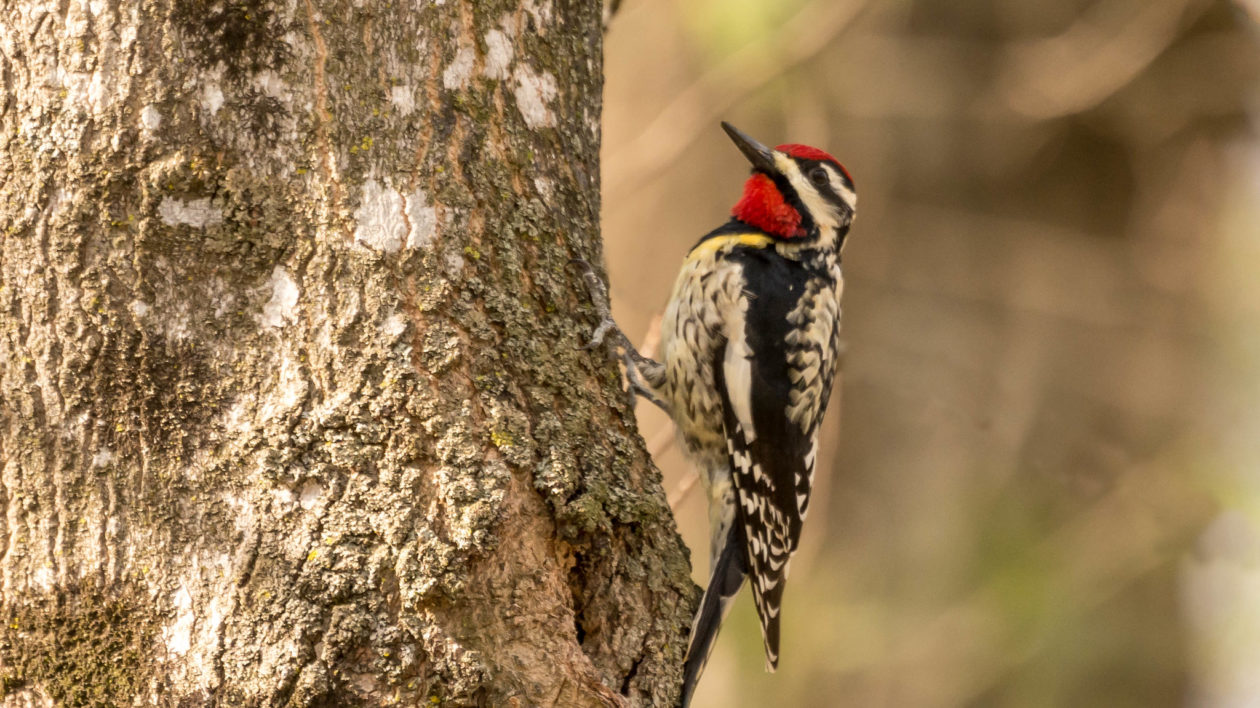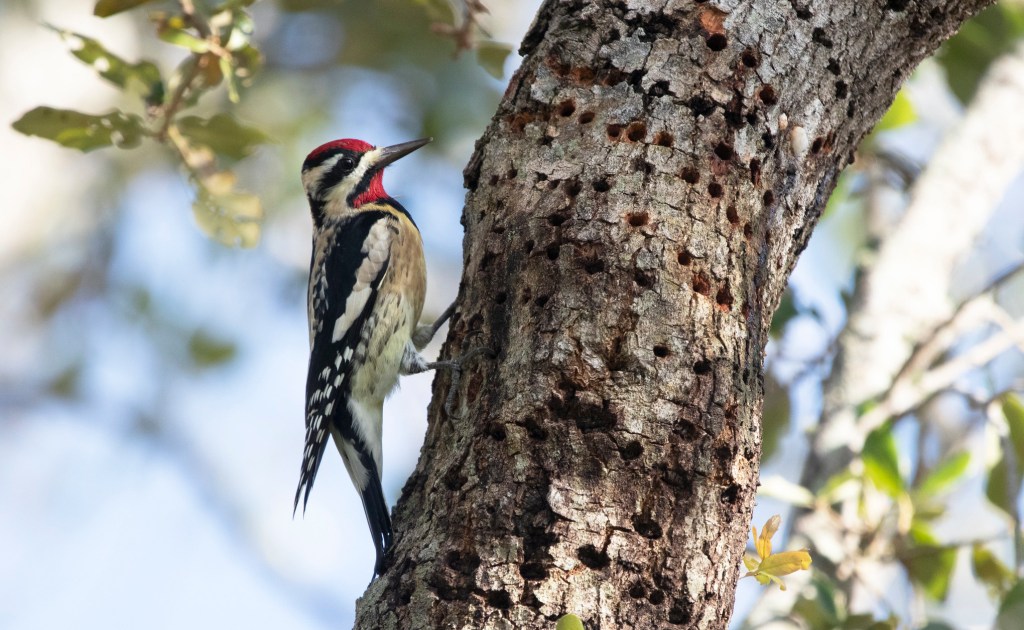What’s in a name? When it comes to sapsuckers…well, these birds certainly live up to theirs.
The mostly black and white boldly patterned faces of the yellow-bellied sapsucker (Sphyrapicus varius) is found across Canada, eastern Alaska, and the northeastern United States. Besides being fairly small with a short stout beak, these birds have a unique characteristic: they absolutely love sap.
Where exactly does this sap come from? Yellow-bellied sapsuckers will drill a network of little holes called “sapwells” into the bark of trees, where sugar-rich sap wells up from the trees vasculature, which they then drink.
One journal article called them a “double-keystone species” as both their holes and the sap that seeps out are essential for a host of creatures
“In addition to being on the habitat for humanity team, sapsuckers also (begrudgingly) run foodbanks,” says Libby Natola, a PhD Candidate in the Department of Zoology at University of British Columbia, currently studying the evolutionary history of yellow-bellied sapsuckers and their close relatives the red-naped and red-breasted sapsuckers.

Natola goes on to express just how important yellow-bellied sapsuckers are for both the ecosystem as well as biodiversity.
“Many other species of insects, birds, and mammals will also feed on the sweet tree sap. Therefore, if you are lucky to get a sapsucker on your property, they will likely enrich your yard with biodiversity, bring you pollinators, and hopefully spark a little joy.”
Before they begin construction, exactly how do sapsuckers choose the trees that they do to drill their sapwells? Is there a preference? Kaija Gahm, Database Specialist at the Cary Institute of Ecosystem Studies, discusses how she set out to answer this question through her research while in high school in upstate New York.
“I had noticed their sapwells all over the place, and since the bird isn’t common in the Boston area where I live (except as a migrant), I was intrigued. I wanted to learn more about why sapsuckers seem to target some trees more than others. Did it have to do with species, or size, or something else?”

Gahm decided to dive into the literature and began to set up her research project.
“To determine species preference, I looked at the trees with sapwell damage and compared the proportion of each species to the overall proportion of tree species in my study areas,” she says. “Sugar maples made up almost 30% of the tree species I sampled (351 trees total), but they made up only 10% of trees with sapsucker damage. By contrast, the sapsucker seemed to prefer Juneberry and Basswood trees out of proportion to their abundance: those species each made up less than 5% of the sampled trees, but about 30% of the trees with sapsucker damage! Ultimately, my hypotheses about tree species preference weren’t supported.”
Gahm emphasizes that the most exciting part of her study was being able to interact with the sapsuckers.
“Sometimes when I got inadvertently too close to the nest, they would dive bomb me! However, I’m always excited to see them, especially since they’re not a common resident where I live,” she notes.

For nature enthusiasts and birdwatchers, it’s worth the time to stake out these holes. Nora Lambert, a media content specialist, recalls her observations of yellow-bellied sapsuckers and their wonderful architecture, in Washington Square Park, located in New York City.
“It’s always a treat to see sapsuckers quietly tucked away in a tree in the midst of a bunch of argumentative sparrows,” she says. “I first noticed those tidy, sap-yellow rows of wide holes on the trunk of a small tree. The squarish, manicured holes looked almost like farmland seen from a plane. It took a lot of poking around eBird observations and the advice of my experienced birder dad to finally figure out that it really was a yellow-bellied sapsucker.”
Lambert goes on to describe how other birds seem to be fond of the sapsucker as well.
“I usually see them in large bushes or small trees with softer trunks – that’s where they like to make their wide sap holes rather than the narrower, deeper ones,” she says. “Robins seem to be fond of the same trees as the sapsuckers are, for some reason; as long as there are not too many sparrows around making noise, there are three trees in the park in which I’m almost guaranteed to see either a robin or a sapsucker. Urban birding really is a secret joy of city life that I hope more people can discover.”
Georgia Silvera Seamans, another avid birder, recalls her yellow-bellied sapsucker observation, which also occurred in Washington Square Park. Silvera Seamans also notes the park as being the place where she first fell in love with the species.
“I don’t recall the exact date or reason I fell in love with the yellow-bellied sapsucker, but I know the place where it happened: Washington Square Park,” she says. “The park is my patch. You can find sapsuckers there from late fall through early spring. I have observed sapsuckers mining or digging new sap wells in deodar cedar, holly, hawthorn, and crabapple. I enjoy watching them dig and mine sap wells.”
Even into the future, many will get to continue to experience the presence of the yellow-bellied sapsucker. Sapsuckers are tied to early successional, or regenerating, stands of trees. Because of the pastoral history of the east coast, the forests were largely cleared for agriculture in the 1700s and 1800s and then abandoned and are in various stages of regrowth. Now there is probably more suitable habitat for sapsuckers than there was even in the pre-colonial era when the forest was largely old-growth.
They are not of conservation concern and are likely doing better than ever! But if you see a little hole in a local tree, stop and take a look: you’ll likely become a fan of this interesting little bird, too.




I have a sapsucker here that has been feeding off a large pine that is probably 100yrs old. The tree is approximately 3’ in diameter, maybe larger. Marietta, Ga
Here in far Northeast Wisconsin, they seem to target the birch. Soft and sappy, what’s not to like.
This past late winter, I took notice how the red squirrels will chew a sugar maple branch just enough to get the sap to flow and enjoy the raw syrup. Small icicles of sap will form and the chickadees will feed off of those.
Calories are at a premium and the maples are all to willing to share. Another dot connected.